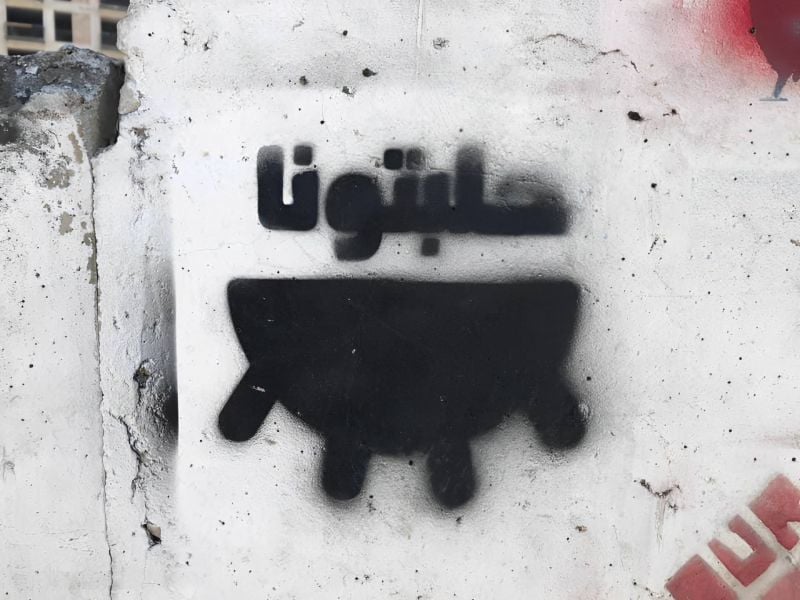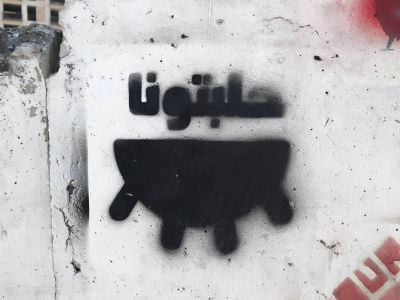
A graffiti in Beirut representing a cow's udder, with the inscription above in Arabic: "You milked us." (Credit: Philippe Hage Boutros/L'Orient-Le Jour)
The 2022 state budget — the first since 2020 and almost 11 months overdue — went into effect on Nov. 15. The delay prompted a group of MPs to lodge an appeal earlier this week before the Constitutional Council.
Among the tax measures contained in the budget are a series of changes in the calculation of income tax that are designed to adjust the Lebanese law to the financial reality of the country, which has been grappling with an acute economic crisis since 2019.
This a crisis that is marked by a collapse of the national currency — hovering around LL41,000 to the dollar on the parallel market, 27 times more than the official peg of LL1,507.5 pounds — illegal banking restrictions, and a major contraction of GDP.
Specified by a series of decisions — notably circular no. 686/1 and no. 687/1 of 23 November 2022 — issued by caretaker Finance Minister Youssef Khalil, these tax amendments affect both employees and employers and are described from all sides.
In the wake of growing discontent among trade unions, the economic bodies on Thursday criticized the changes as “the coup de grace to the private sector” and called on the finance minister to review the document.
While some companies have started to implement the new measures, others are still waiting, while their employees are beginning to realize the extent of what awaits them if the current course is maintained.
L'Orient-Le Jour takes a dive into the consequences of these amendments for employees and pensioners in the private and public sectors, with Nadim Daher, an expert accountant and member of the board of the Lebanese Association for Taxpayers' Rights and Information (Aldic ).
Which provisions are problematic?
The measures decided on by the caretaker government of Najib Mikati and approved by the MPs who adopted the 2022 budget are articulated in three provisions.
The first — under Article 33 — increased the seven progressive brackets for taxes on salaries, wages and pensions, but without changing the applicable tax rates, which are successively 2, 4, 7, 11, 15, 20, and 25 percent for monthly salary amounts.
Prior to the 2022 budget, the seven brackets of taxable income after allowances (a cut set by law, according to the taxpayer's circumstances) ranged from less than LL6 million to LL12 million per year.
To keep pace with depreciation, the budget increases the existing brackets from LL18 million to LL675 million per year.
“They have been multiplied by three,” Daher said.
These new brackets apply retroactively to the calculation of the taxable base as of Jan. 1, 2022.
The calculation is still the same: a taxable monthly salary after deductions of LL41 million ($1,000 in “fresh” dollars) will be taxed at 2 percent for the LL1 million to LL1.5 million bracket; at 4 percent for the LL1.5 million to LL3.75 million bracket, and so on.
The brackets are retroactive but taxes paid up to October are will not be discounted, according to the statement of the minister's decisions, which is rather vague on this point.
The second provision is dictated by Article 35 and introduces the notion of an “effective [exchange] rate,” instead of the former official peg, to refer to the amount in lira of the salary and wages tax withheld by the employer and owed by employees to the tax authorities.
However, in decision no. 687/1, the caretaker finance minister decided that the Sayrafa platform rate would be applicable to convert salaries paid in foreign currency in cash or transferred from abroad, the equivalent of “fresh dollars,” as opposed to those blocked in the banking sector called “lollars,” or “bank dollars.”
The Sayrafa platform is operated by the Banque du Liban and is updated every evening during the business week according to a mechanism that has never been transparently articulated.
The Sayrafa lira-to-dollar exchange rate has been fixed at LL30,300 to the dollar for several days now, which is currently 20 times the official rate.
For salaries paid in bank dollars, a rate of LL8,000 is set for withdrawals in lollars, according to BDL circular No. 151 — a five-fold increase.
Notably, allowances have also been updated (Article 27) and apply throughout the year. For example, the annual allowance for a single person was LL5 million and it has increased to LL37.5 million — a 7.5-fold increase, according to Daher.
Implications for employees
These changes significantly increase the amount in taxes that employees who have been given raises or are paid partly in fresh dollars must pay to the tax authorities.
They may also increase the amount in contributions that employers have to pay to the National Social Security Fund (NSSF), although no decision has yet been issued by the finance minister to clarify the specific consequences.
“The imbalance is clear. While the exchange rate is multiplied by 20 for cases where the Sayrafa rate applies and by five for those where the bank dollar rate applies, the brackets have only been multiplied by three,” Daher explained.
Someone who earns about the same as before the crisis in real terms — ie, in fresh dollar equivalents — will pay more taxes, both in lira and in dollars, even though their purchasing power will still be eroded by inflation in lira and dollars.
Prior to the approval 2022 budget, a taxable salary of $1,000 in "fresh," or "lollars," after deductions could be reported to the tax authorities at around LL1.5 million. Notably, at the real market rate, this is worth only $37.
The tax payable was therefore LL57,500, according to our calculations verified with an accountant quoted anonymously. That's $38 at the official rate and $1.40 at the LL41,000 rate.
After the 2022 budget took effect, the same $1,000 fresh salary is worth more than LL30.3 million at the current Sayrafa rate (LL30,300 to the dollar), and the tax levy rises to LL3,532,000 million, or the equivalent of $86 in fresh dollars.
Using the same methodology, the tax liability on a salary of $1,000 in bank dollars (convertible at LL8,000 to the dollar) is LL437,500 or $10.60 fresh dollars.
Implications for employers
The consequences of this change for the employer are equally significant, as the brackets apply retroactively from Jan. 1, 2022.
The taxable income, from which the employer must calculate the contributions to be paid to the NSSF such as the 8.5 percent to be paid for end-of-service allowances, to name but a few, would be multiplied by more than five for salaries paid in bank dollars (LL8,000 rate) and by 20 for those paid in fresh dollars based on Sayrafa.
“The consequences are immeasurable for the calculation of end-of-service benefits, which could push some companies into bankruptcy,” Daher said.
An unbalanced system
It is not surprising that the approval of these measures is causing greater outcry than the decision on the customs dollar, which was issued on Wednesday and raises the exchange rate used to calculate tariffs to LL15,000 on the dollar.
Not only do these changes potentially explode the payroll taxes of employers who have increased their number of employees during the crisis or paid them in fresh dollars to offset the collapse of the currency, but also sharply increase the taxes paid by private sector employees who still face an ever-increasing cost of living.
The fact that no serious reforms have yet been launched to downsize the civil service staff, rehabilitate public services, or put an end to the banking restrictions that depositors have been suffering under for three years will render the measure even less acceptable to the private sector.
Moreover, all these calculations have to be made via the Sayrafa rate, whose opaque operation limits the visibility of employers, especially since the gap with the market rate is never really stable.
Meanwhile, authorities defend this update as a necessary evil to adjust an unbalanced taxation system.
Speaking on television a week ago, Director General of Finance Mohammad Louay Hajj Shehade said that someone like him, who works in the government and earns LL4.7 million (roughly $3,100 at the official rate and $115 at the parallel market rate) paid more income tax than a private employee who was paid $2,000 fresh (LL3 million declared at the official rate, but worth LL82 million at the black market rate).
A necessary alternative
Daher said the ruling class is not wrong on this point but is not looking at the problem from the right angle.
“The problem is that today, a salary of $1,000 in fresh — which is today equivalent to LL41 million — does not weigh much in the face of inflation,” he said.
“There is a real problem of tax fairness when the same salary in real terms [fresh dollars] is taxed at double or even triple the rate, without actually getting richer,” he added.
"The system that was adopted with the budget is not sustainable, but it is not possible to stay with the old system either,” Dagher continued. “We need to find an alternative formula that mitigates the impact of the tax update on companies, taking into account inflation while adapting the brackets to the reality of the purchasing power of wages.”
Like the economic organizations' declared stance on Thursday, Daher said it is imperative that any adjustment of the tax system be part of the broader reform in Lebanon, as piecemeal solutions are bound to cause new imbalances.
This article was originally published in French in L'Orient-Le Jour. Translation by Sahar Ghoussoub.
